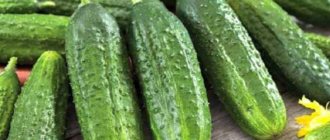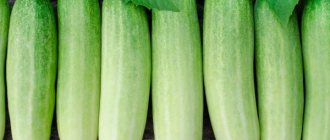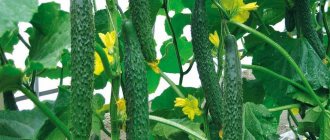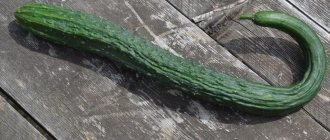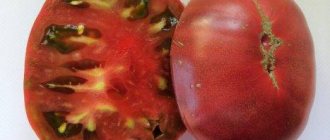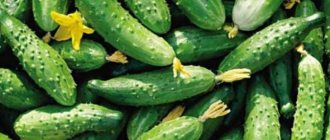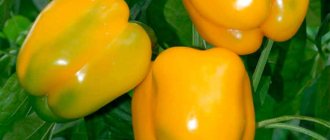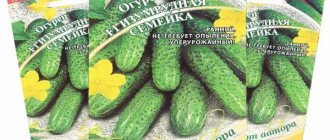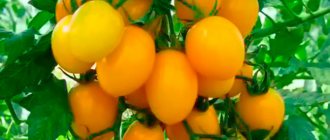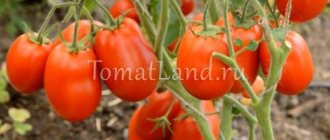Cucumber Lord F1 will appeal to owners of light, removable shelters and outdoor gardens. This hybrid bears fruit well in unprotected soil, its greens are tasty and aromatic, and their purpose is universal.
| Landing location | Ripening time | Mode of application | Fruit length | Group | Fruit smoothness | Pollination method |
| Open ground | Mid-early (46-55 days) | Universal | Medium - from 10 to 15 cm | Hybrid | Slightly lumpy | Bee pollinated |
Winter and summer varieties
There is a large group of shade-tolerant cucumber hybrids cultivated in heated greenhouses from January to July or until the end of October (F1 Marathon, F1 Relay, F1 Manul, F1 TSHA 442, F1 Ladoga, F1 Northern Lights, F1 Olympics, etc.).
| Cucumber F1 Relay |
Cucumber F1 Ladoga | Cucumber F1 Gladiator | Cucumber F1 Olympics |
Winter cucumbers are bee-pollinated and parthenocarpic, tuberculate and smooth-fruited. The average length of greens is 15-25 cm; There are also long-fruited forms (with smooth green foliage) - up to 30-35 cm long. All winter hybrids are late-ripening, characterized by strong vegetative growth and large leaves. The most popular are lumpy white-thorn hybrids with fruits of a beautiful bright green color, 15-22 cm long, large-tubercular, with excellent taste, for salad purposes. Such cucumbers can be seen on store shelves in winter. All bee-pollinated hybrids must be supplemented with 10-15% pollinating hybrids (F1 Gladiator, F1 Hercules, F1 Ermine).
All major cucumber hybrids cultivated by gardeners and farmers in the summer are included in the spring-summer cucumber group . Such hybrids are the fastest to ripen and have complex resistance to diseases. Among them there are both parthenocarpic and bee-pollinated forms; The length of greens varies from 6-10 cm (gherkins) to 20 cm. This also includes bunch hybrids.
A line of popular shade-tolerant cucumber varieties
These varieties can withstand short-term shade (from buildings, tree crowns), and do not reduce the rate of fruit formation. Among them:
- Tundra is a cucumber variety specially bred for the northern regions for open ground. The first fruits are ready for harvest in 40-43 days. Greens with tough skin and fragile flesh. Taste characteristics are at the level. The main use of Tundra is pickling, although such cucumbers are tasty in salads and fresh;
- Maryina Roshcha is a shade-tolerant cucumber with beautiful white-thorned greens. Length – 11-12 cm, dense structure, aroma present. The peculiarity of the hybrid is the long yield of the crop, which is convenient for canning and pickling;
- Master F1 - distinguished by strong branching of the lateral branches. Fruitful, bears fruit well in the northern regions, forming 1-2 ovaries at the nodes. The fruits are smooth, white-thorned, up to 15 cm in length;
- Rushnichok - bred by breeders. Early ripening, needs pollination. Included in the “Russian Taste” series thanks to its dense and crispy greens, suitable for pickles and marinades. Up to 6-7 kg of greens are harvested from the plant. The fruits are elongated, with corrugated tuberculate skin, up to 14-16 cm. Despite the length, they retain their shape (slices) well when preserved;
- cucumber Danila - from the group of early ripening cucumbers, with large cucumbers up to 15 cm. They are cultivated in greenhouses, and even in low light conditions the formation of greens is not reduced. Fruits with frequent whitish pubescence, good taste;
- Zadavaka F1 and Zabiyaka F1 cucumbers are two “twins” from agro. Even the seed packets contain the slogan: “Don’t give up in the dark!”, thereby highlighting the shade tolerance of the hybrids. The harvest of fruits is early; after 42-44 days, the greens from the first batches are ready for harvesting. Use - for pickling, since the skin of the fruit has many tubercles and black thorns. According to culinary experts, these are the cucumbers that are crispy when pickled and marinated;
- hybrids of the Relay variety type - cucumbers from - are grown for use in salads. They are distinguished by their bright taste, tender juicy pulp, and shade tolerance. These include cucumbers Marathon, Ladoga, Northern Lights, Manul f1, Relay.
Parthenocarpic and bee-pollinated varieties
Parthenocarpic forms are best suited for protected soil (greenhouses), since crop formation does not depend on pollinating insects, which are worse at pollinating plants in greenhouses. But parthenocarpy (production of fruits without pollination) is a trait that depends on growing conditions; any stress in plants (temperature changes, drought, excessive humidity) reduces its manifestation.
Cucumber F1 Farmer | Cucumber F1 True Friends |
Under temporary film shelters and in open ground, both parthenocarpic and partially parthenocarpic and bee-pollinated hybrids can be successfully cultivated. Among bee-pollinated cucumbers, the most popular varieties are those with a female flowering type (F1 Farmer, F1 Lord, F1 Faithful Friends, F1 ABC, F1 Acorn, F1 Captain, F1 Compass, F1 Teremok, etc.), they are more productive.
Cucumber F1 Acorn | Cucumber F1 Teremok |
But for high-quality pollination, they need to be sown with varieties that produce a large number of male flowers (barren flowers). Breeding companies put colored pollinator seeds in bags of the main bee-pollinated hybrids. These bags have a special symbol - a yellow seed in a pink square and the text "colored seeds - pollinator."
Cucumber F1 Captain | Cucumber F1 Compass |
Features of cultivation
Lord f1 feels better in open ground, so in warm climates it is grown in a regular garden bed. The cucumber in question has powerful, spreading bushes - it will require a fairly spacious area. As for soil characteristics, the variety prefers loose, medium-loamy soils.
Soil preparation
This cucumber grows best in areas where legumes, cruciferous vegetables, tomatoes, or potatoes were previously cultivated. In mid-September, the area for the Lord f1 hybrid is cleared of plant debris, dug up to a depth of 50-55 cm, disinfected with a solution of copper sulfate and fertilized with a solution of mullein.
With the arrival of spring, 3-4 days before planting the variety, the soil is loosened by 10-12 cm, weeded, selecting overwintered insects, and the soil under Lord is fertilized with rotted sawdust.
Germination of seedlings
Lord f1 seeds are planted for seedlings closer to the middle - second half of April. It all depends on the climate and weather conditions. River sand, humus, chicken droppings and wood ash are added to the soil. Seed material is planted in peat tablets, 1 seed per container. The variety's seedlings are kept at a temperature of 24°-25°, after germination - about 23°. Water every other day. On the 5-6th day after germination, the sprouts are fertilized with superphosphate.
Landing in the ground
The seedlings are transferred to the garden bed in the middle - second half of May. By this time, 3-4 leaves are blooming on each sprout. The soil for the cucumber should warm up to 14-15. The bushes are planted in holes 9-10 cm deep. The recommended distance between the bushes of the variety is 55-60 cm. The ideal row spacing for cucumber is 70 cm. Only 1-2 bushes can be placed per 1 m² in a greenhouse, and no more than 3 - in open ground.
Cold-resistant varieties
Due to their biological characteristics, not all cucumbers can tolerate the spartan conditions of the garden bed. Cold-resistant varieties and hybrids adapted to the drying effects of wind and low air humidity are grown in open beds. In addition, green plants should not lose commercial quality if they are pollinated.
Cucumber F1 Petrel | Cucumber F1 Buyan |
Cucumber F1 Be Healthy | Cucumber F1 Green Wave |
F1 Anyuta, F1 Be healthy, F1 Petrel, F1 Green Wave, F1 Brawler, F1 Karapuz, F1 Little Thumb, F1 Maryina Roshcha, F1 Dragonfly, F1 Ant, F1 Matryoshka, F1 Grasshopper, F1 Trump Card, F1 Junior Lieutenant, F1 Three Tankmen, F1 Hit of the Season, F1 Trump Card, F1 Okhotny Ryad, F1 First Class, F1 Cheetah, F1 Balalaika and the partially parthenocarpic F1 Saltan fully meet these requirements.
Cucumber F1 Ant | Cucumber F1 Okhotny Ryad |
Cucumber F1 Saltan
Shade-tolerant varieties
Cucumbers vary significantly in their shade tolerance. In summer, you should grow cucumbers of the summer-spring ecotype, which includes most varieties for amateur gardeners. Winter cucumbers, despite their shade tolerance, are not advisable to plant in summer: they are late in ripening and are more likely to be affected by summer diseases (primarily downy mildew). Light-loving hybrids include all hybrids with bunched ovaries in nodes. In partial shade conditions, it is better to plant shade-tolerant hybrids (F1 Arina, F1 Moscow Evenings, F1 Danila, F1 Master, F1 Secret of the Company).
Cucumber F1 Arina | Cucumber F1 Secret of the Company |
Some bunch gherkins are also shade-tolerant (F1 Maryina Roshcha, F1 Chistye Prudy, F1 Hit of the Season, F1 Green Wave).
Cucumber F1 Maryina Roshcha | Cucumber F1 Chistye Prudy |
Diseases and pests
Lord f1 can boast of complex immunity. This cucumber is resistant to diseases such as olive spot, powdery mildew, cucumber mosaic and fusarium. Parasitic insects visit the plantings of the variety infrequently. The only thing the hybrid is afraid of is peronosporosis.
Downy mildew
Downy mildew appears on Lorde in greenhouse conditions, with high humidity and lack of oxygen. The disease manifests itself as a grayish-beige sticky thick coating on the leaves of the variety. At the first signs of peronosporosis, the cucumber is sprayed with a solution of milk (whey) and iodine, or with garlic tincture. In case of severe infection, Lord f1 bushes are treated with Quadris or Strobi.
Thrips
Small oblong beetles infect cucumbers when plantings are thickened and weeding is poor. The main sign of the appearance of thrips is yellowing of the foliage of the variety and the appearance of small holes. You can get rid of the pest by spraying a tincture of chopped onion and garlic. If the Lord is severely affected by parasites, use Vertimek, Karbofos, or Agravertin.
Early ripening varieties and varieties with a long fruiting period
In cucumber, there are significant varietal differences in the duration of fruiting. If you want to get a high yield in a short period, grow early ripening sprinter hybrids (F1 Regina-Plus, F1 Amur, F1 Bouquet, F1 Alphabet), which produce most of the harvest in the first month of fruiting.
Cucumber F1 Cupid | Cucumber F1 Bouquet |
Cucumber F1 Alphabet
In order to collect a large number of greens in late summer and early autumn, cold-resistant cucumbers with a long fruiting period are planted (F1 Virenta, F1 Saltan, F1 Anyuta, F1 Farmer, F1 Lord, F1 Little Thumb, F1 Maryina Roshcha).
Cucumber F1 Virenta | Cucumber F1 Boy with Thumb |
According to the ripening period, cucumbers are divided into three groups: early ripening - the period from germination to the beginning of fruiting is less than 45 days, mid-ripening - from 45 to 50 days, late ripening - more than 50 days. Plants begin to bear fruit within the time period indicated on the bag of seeds if they were in favorable conditions. Any cucumbers, even the most cold-resistant ones, are significantly delayed in development at low temperatures, which delays the onset of fruiting. Therefore, you should not rush to sow or plant seedlings; do them at the optimal time (for central Russia in unheated greenhouses - from May 15-20, in open ground - from June 1-5).
Description of popular varieties of cold-resistant cucumbers
Cold-resistant and shade-tolerant varieties of cucumber are increasingly being used for cultivation in summer cottages. This is due to the fact that they are not afraid of sudden drops in temperature, and unfavorable and cold weather will not affect the yield.
Cold-resistant varieties of cucumbers for open ground:
- Cucumber Lord
Manul cucumbers. Cucumber Lord F1 is a medium-ripening variety. Refers to the first generation hybrids with an average period of fruit ripening. The inflorescences are formed mainly by females. A characteristic feature is the active growth of the lash. Side shoots grow very quickly. The maximum harvest can be harvested in August - the first ten days of September, when most varieties have already stopped bearing fruit.
See also
Is it possible to plant zucchini and cucumbers next to each other, their compatibilityRead
- Cucumber according to Pike's command F1
A variety with a long fruiting period. Vegetable ripening begins 50-55 days after the sprouts appear. The bush forms one stem; practically no side shoots are formed. No pollination required. Frost-resistant variety with small cucumbers. Fruits until frost.
- Cucumber Flagship F1
Cold-resistant cucumber variety with good yield. Plants pollinate on their own. The variety belongs to the mid-early variety; about 45 days pass from the moment of germination to harvesting. The first harvest can be harvested as early as July. The main advantage of a cucumber is its immunity to many vegetable diseases. Cucumbers are versatile in cooking.
- Ruffnut F1
Another variety that belongs to the mid-season. The formation of internodes occurs on the side shoots. Each internode ends with a fascicular ovary. It produces 4-5 fruits. The shape of the cucumbers is cylindrical, they are not more than 10 cm in length. Cucumbers of the Zadavak hybrid are covered with white tubercles. The color of ripe fruits is dark green.
- Cheetah F1
A shade-loving plant that can be cultivated in open ground. Refers to the first generation hybrids. High yield throughout the entire fruiting period, pollinated without the help of bees. It is resistant to diseases such as powdery mildew and downy mildew. The fruits grow no more than 15 cm in length. There is no bitter taste. The skin is covered with tubercles.
- Saltan F1
Cucumbers with a long fruiting period. The bushes have abundant branching with a forming dense crown. It is immune to powdery mildew and tobacco mosaic virus. The inflorescences are formed predominantly by females. Cucumbers are small in size, gherkins. The skin is green in color, no more than 13 cm in length. First-generation hybrid with medium-early ripening vegetables. From the moment of emergence of seedlings to harvesting, no more than 45 days pass.
Pickling and salad varieties
Cucumber varieties are distinguished by purpose. There are salad, canning, pickling and all-purpose cucumbers. Pickling qualities depend on the density of the skin and the content of pectin and sugars.
Black-thorn varieties are traditionally considered pickling varieties. But the pickling qualities do not depend on the color of the pubescence, but on the density of the skin and the content of pectin substances and sugars in the fruit. Many modern varieties and hybrids have high pickling qualities: F1 True Friends, F1 Saltan, F1 Anyuta, F1 Farmer, F1 Lord, F1 Chistye Prudy, F1 Green Wave, F1 First Class, F1 Acorn, F1 Dragonfly, F1 Ant, F1 Grasshopper, F1 Matryoshka, F1 Trump Card, F1 Alphabet, F1 Bouquet, etc.
Cucumber F1 Lord | Cucumber F1 First Class |
Salad cucumbers have medium-sized smooth or lumpy fruits. Greens have no bitterness, they have a crispy, sweetish flesh and are eaten fresh (F1 Zozulya, F1 Bazaar, F1 Bukhara, F1 Tamerlane, F1 Kochubey, F1 Marta, F1 Makar, etc.).
Cucumber F1 Bukhara
Cucumber F1 Bazaar | Cucumber F1 Makar |
Bunch varieties
Cucumbers with bunched ovaries in nodes are very popular among gardeners. Their main advantages: an abundance of ovaries and greens, gherkin fruits, excellent pickling qualities, high yield. In the nodes of bundle hybrids, from three to eight or more ovaries are formed simultaneously, and on one plant in a season it can grow up to five hundred! Zelentsov.
Cucumber F1 Grasshopper | Cucumber F1 Dragonfly |
Cucumber F1 ABC | Cucumber F1 Matryoshka |
Bundle hybrids can be parthenocarpic (F1 Maryina Roshcha, F1 Matryoshka, F1 Grasshopper, F1 Dragonfly, F1 Green Wave, F1 Trump Card, F1 Buyan, F1 Hit of the Season, F1 Balalaika, etc.) and bee-pollinated (F1 Faithful Friends, F1 Teremok, F1 Captain, F1 Acorn, F1 Compass, F1 ABC, etc.).
Nuances of crop care
General agricultural technology for shade-tolerant and cold-resistant cucumbers is standard. Basic techniques:
- irrigation;
- feeding;
- mulching (replaces loosening);
- weeding;
- formation of plants (pinching side shoots, taking into account the type of branching);
- protection against diseases and pest attacks (preventive treatments).
But at the same time, some subtleties are taken into account. Bee-pollinated varieties are given places in the open air, parthenocarpics are planted in greenhouses. Bundle hybrids, despite their resistance to slight shading, require a lot of light. Otherwise, the plants lose their “bundling” and a standard number of ovaries (1-2) are formed in the axils.
Parthenocarpic hybrids intended for greenhouses for summer-autumn and winter-spring rotation are unsuitable for cultivation in summer. They grow successfully in shelters, form a large number of ovaries and fruits, but do not adapt well to open ground conditions.
